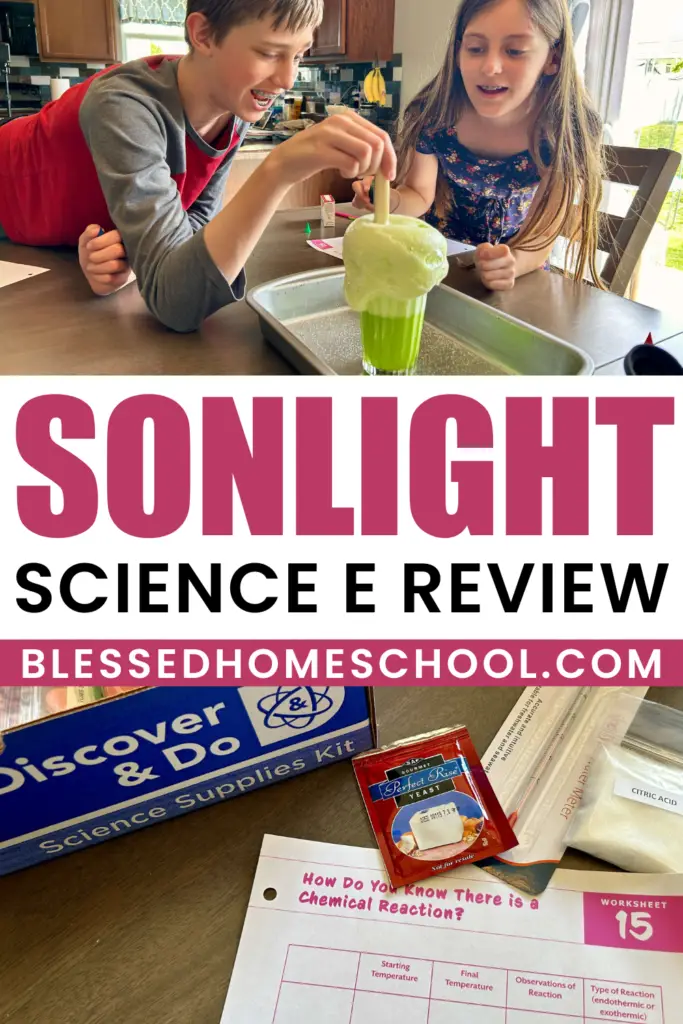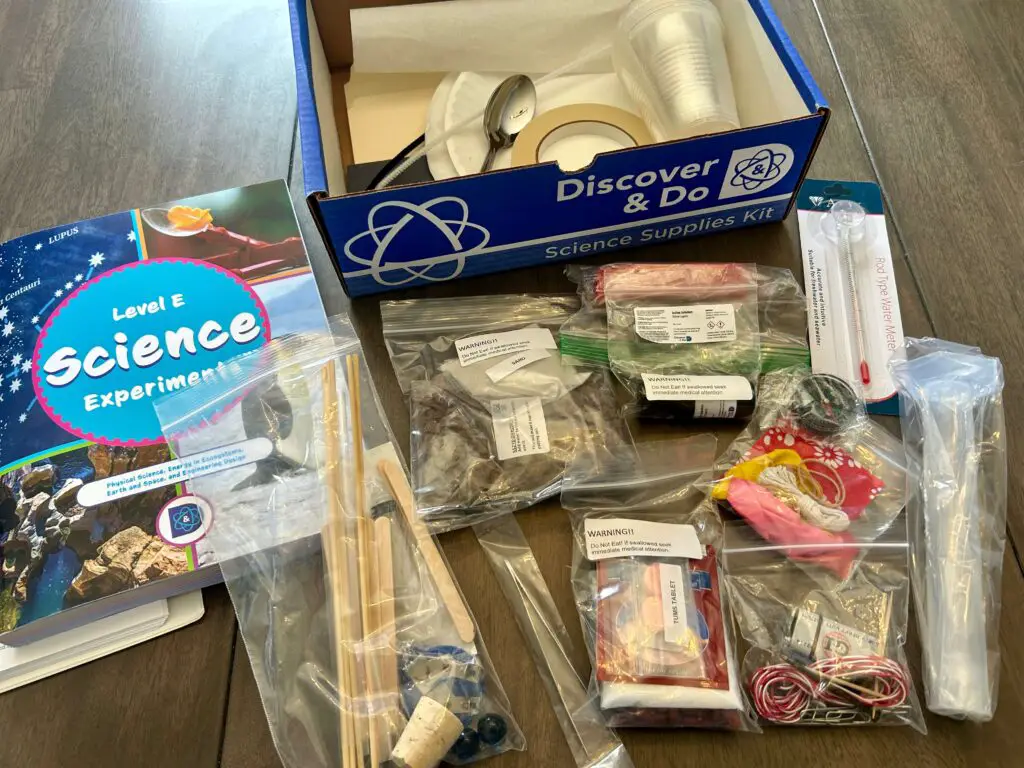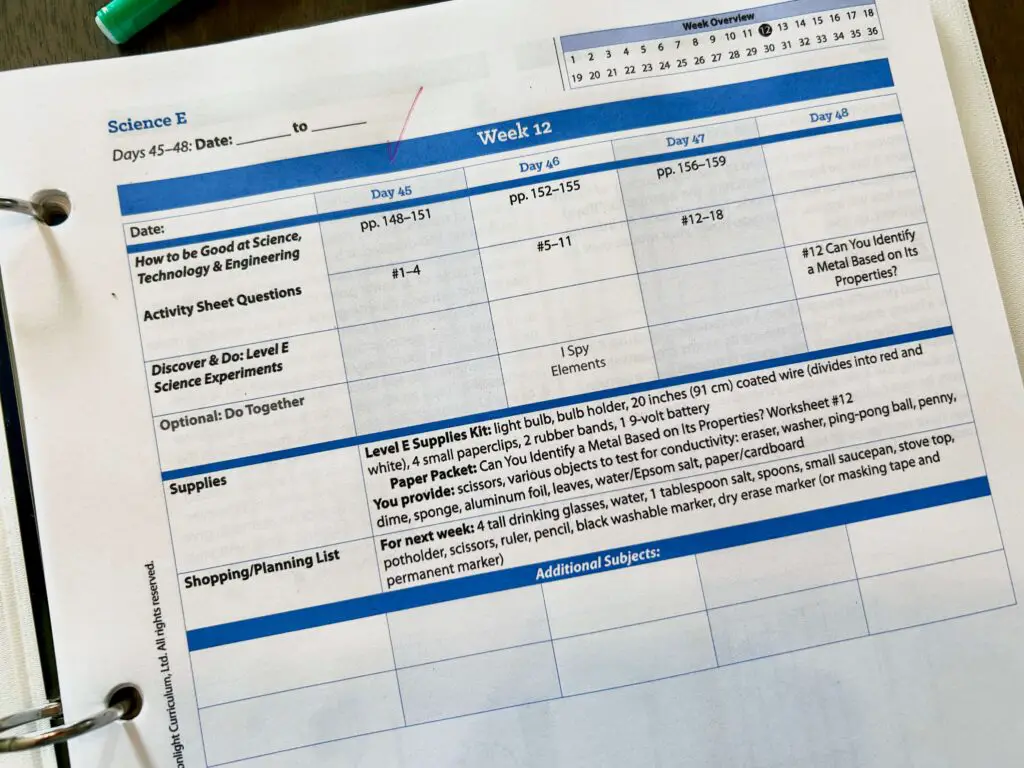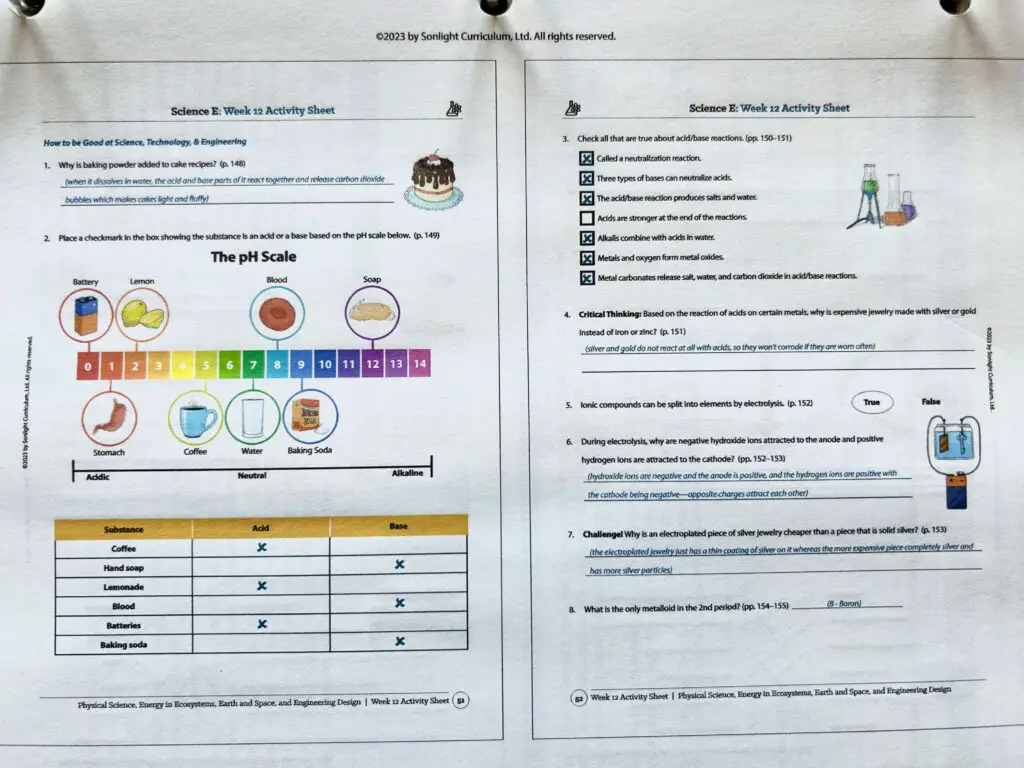Sonlight Science: Is This Popular Curriculum For You? A Detailed Review
Just so you know, this post contains affiliate links. That means if you use them to make a purchase, I may earn a commission. You can read my full affiliate disclosure HERE.
I really hate to admit this, but there is something I pretty much always skip during our science lessons: experiments.
It’s not that my kids don’t love them. I know they typically do.
The main reason I skip them is that I barely have the foresight most days to prep and have all the materials on hand when we actually need them.
Second, we run out of time most days.
Third, sometimes science experiments seem very simplistic (my kids already know what the “end result” will be, so they’re not meaningful. It just feels like “busy work”).
And let’s not forget the time I accidentally left the highly flammable gas on in chemistry class (thank the Lord for smart lab partners!).
Needless to say, when I had the opportunity to try out one of Sonlight’s Science Curriculums (Science E), I jumped at the chance.
A kit that includes most of the supplies we’d need for our experiments so I don’t have to buy and organize them??
A 4-day science schedule that we might actually be able to fit in?
Science experiments that actually help kids apply scientific principles to what they learn about in their readings each week?
Sign me up!

We’ve been using Sonlight Science E for about 4 months now in our homeschool, so I’ve got a good feel for it. I’m going to share all about this curriculum with you (my honest review!) so you can make an informed decision on whether or not this would be a good fit for your homeschool.
Sonlight Science Curriculum 🔬
Sonlight is well-known in the homeschool community for being a literature-based, low-prep curriculum option.
You can purchase individual subject curriculum (like science, language arts, math and more), a History / Bible / Literature Program, or opt for one of their All-Subject Packages.
As far as their science offerings, they have curriculum for kindergartners all the way through upper-level advanced high school programs.
They also sell Discover and Do Kits which contain most of the items you’ll need to complete the experiments in their curriculum. I absolutely love this, because it means less prep for me (and less scrambling for supplies on experiment day!).

The Science E curriculum we tried is geared for ages 10-13 (or about grades 5-8), so I thought it would be a great fit for my 12 year old and twin 10-year old daughters. This level focuses on Physical Science, Energy in Ecosystems, Earth and Space, and Engineering Design.
What’s Included in Sonlight Science E 🧪
This curriculum has 36 weeks worth of lessons, and it’s very much open-and-go, which is always a big plus in my book!
When you purchase the Sonlight Science E package, you’ll get the following:
Instructor’s Guide 📗
You have the option to choose a 4-day or 5-day schedule for science, so your Instructor’s Guide will reflect this! I went with the 4-day option.

The Instructor’s Guides are so comprehensive and easy to use. They’re what truly make this an open-and-go curriculum!
You’ll see from the picture above that you have a column for each day you’ll do a science lesson, and then it tells you exactly what books and activity pages you need to do together.
It’s foolproof!

Occasionally, there will be extra notes included that you can add to your teaching that day, or optional activities. These are all included in the Instructor Guide and clearly marked.
Student Activity Sheets 📖
These are included with your Instructor Guide, but if you are using this program with multiple students, you’ll need to add-on additional sets.

If you think you might use this in future years with younger kids, I’d recommend grabbing extra Student Activity Sheets when you make your initial purchase, just in case changes are made in future years.
You’ll also get answer keys to the Activity Sheet Questions your kids will be completing:

My kids and I both have really liked the worksheets; they are fairly simple, don’t take long, and go along directly with the daily reading (so it’s easy to tell whether or not my kids comprehend that day’s lesson).
I like that they’re not overwhelming for my kids, and they’re not busywork, but a great reinforcement tool.
Literature 📚
The following books came with our 4-day week package:
- Discover & Do: Level E Science Experiments
- Water
- Listening to Crickets
- The Usborne Book of Astronomy and Space
- How to Be Good at Science, Technology and Engineering
- Level E Science Experiments
The 5-day option also comes with the book “How Things Work” from National Geographic Kids.
Discover & Do: Science Supplies Kit E 🧫
As I mentioned before, this kit is amazing! It includes most of what you’ll need to complete all of your Level E science experiments. Everything is sorted into labeled bags, and clearly marked in the Instructor Guide when you’ll need to use it.
Another thing to note about the Instructor Guide is that each week, they give you a heads up about the next week’s experiments, so if there IS anything you need to make sure you have prepped, you have plenty of time (and a reminder!).
Discover & Do: Level E Experiments Paper Packet 📝
These are simply worksheets that match the Experiments book. You can write in the book if you want to, but I much prefer these worksheets.


Next, I’ll give you a more in-depth glimpse at each of the books included in the curriculum. But first, I want to touch base on something that you might consider pretty important when selecting a science curriculum: worldview.
Worldview in Science 🌎
On Sonlight’s website, they note that they are a Christian homeschool curriculum, but I think that both Christian families and homeschool families that prefer secular options can use this course successfully.
Each of the books chosen to study in Science E are secular in nature, and Christian content is absent in the literature.
The Instructor Guide notes that due to this, you as a parent have the freedom to share your own viewpoints if they differ from the text. For example, you might read a lesson about evolution or age of the earth, and the Instructor Guide will mention that this is a good time to chime in with what you believe on these topics.
u003cemu003eu0022And we encourage your family to first seek to understand differing perspectives before critiquing them, so your children gain the ability to discern.u0022u003c/emu003e
There are a few Bible verses included in the Instructor Guide, but I wouldn’t say the curriculum as a whole is Biblical-worldview shaping or overtly religious.
Sonlight Science E Literature 📕
The literature that comes with this curriculum is definitely not your average dry textbook. The books are very interesting, colorful, and definitely captured my kids’ attentions!

If you are teaching multiple kids, you might consider getting extra copies of the books. There is so much information in them, and so many interesting pictures and diagrams to looks at — it definitely would have made it a bit easier if my kids all had their own copies to read while we did our lessons!
How to Be Good at Science, Technology & Engineering 🥼
This book breaks down and aims to explain tricky concepts in the STEM realm. I think it does a pretty good job with that!



Overall, this is a beautiful book, colorful, and interesting. Typically we read 4 pages per lesson, and there is a LOT of information to take in.
But, as noted in the Instructor Guide, it’s ok if your kids don’t memorize or become experts in every little thing; Sonlight Science is circular, so as they get older and return to the same concepts, they will continue to study them more in-depth. Right now, a big focus is familiarizing them with many interesting topics.
You can take a look at the entire Table of Contents in my Flip-Through video if you’re interested in learning more about the topics this book covers!
Water 🌊
In week 5, you’ll begin using the book “Water” occasionally. Like the other literature included, this book is very colorful, engaging, and has lots of information.


Since we did only have one copy of each book, I usually read the pages and then held up the book to show the pictures and diagrams, and then let my kids pass it around to look at themselves.
The Usborne Book of Astronomy & Space 🔭
In week 23 of the curriculum, we will begin using the Usborne book of Astronomy and Space.


If you choose to teach from a Biblical worldview, this science literature is not going to do that for you. All of the information is presented from a secular point of view, and it will be up to you as the parent to interpret what you are reading from the lens of Scripture and offering your beliefs and viewpoints. It definitely can add some very good discussion points to your lessons!
Listening to Crickets 🥽
In week 35, we’ll begin reading chapters of “Listening to Crickets” together, and do about a chapter a day. I’ll do this as a read-aloud to my kids.


Organizing Sonlight Science Curriculum 🗃️
The Sonlight Science E curriculum was a breeze to organize.
I got a different colored binder for each of my kids (red, blue, and black) to hold all of their papers, a white binder for my Instructor Manual, and a crate to keep it all together.
Easy to pull out and use when it’s science time!

In each of my kids’ binders, I have one tab divider. The Activity Sheets for the daily lessons go in front, and all of the experiment pages go behind the tab divider.


After we finish our lesson for the day, they’ll take their completed worksheets and put them behind all of the others, so they always have their “next” worksheets in the front, ready to go.
A Typical Week With Sonlight Science E 🗓️
As I mentioned earlier, I chose to go with the 4-day a week option. It’s worked out pretty well for our schedule.
Some weeks, we can’t fit in all 4 days, but that’s very easy to modify. Sometimes we simply need to forego the experiment, or other week’s we’ll combine a couple of days of reading so we can get it all in.
Each day we have a reading selection from one of the books (most days it’s “How to Be Good At Science, Engineering and Technology”), which takes anywhere from 10-20 minutes depending on the rabbit trails we go down.
After reading, my kids complete their student worksheets.

The worksheets are fairly simple (not much higher-order thinking is involved to complete them); answers typically come straight from the reading. There are a variety of question types.
My kids feel confident after completing these worksheets because it’s easy for them to do if they’ve been paying attention to the reading! It’s nice not having to pull teeth to get a science assignment finished.
Sonlight Science Experiments 👨🔬
Although we do enjoy the readings, the experiments are easily my kids’ favorite part!
Since I already have the Discover and Do box, it’s so much easier to actually do science experiments with my kids.

The Science Experiments book is so easy to follow and gives you step-by-step directions for the procedures you’ll be completing.
The student worksheets also make it very easy for the kids to track data, write down notes, and answer questions during the experiments.
One of the goals Sonlight has is that your kids don’t just memorize the scientific method; but that they actually become scientists, completing the scientific process in fun and memorable ways!
Each experiment starts with having kids make observations and ask questions. They then make hypotheses and perform an experiment to see if they were right!
If you’re interested in seeing more about what experiments are included and what they’re like, make sure to check out my Sonlight Science E flip-through video where I show a detailed look at the table of contents.
Considerations for Sonlight Science E 💡
After using this curriculum for a few months, here are a few things that stand out to me that you might consider when making a decision about this curriculum:
- There is a LOT of great material covered. You might be able to get through it all, but be realistic as well. We started from the beginning, but then after a while I decided to choose the units that were most interesting to my kids to cover, just to make sure we got those done. The units are not linear, so it’s ok to change up the order if you want!
- If you are teaching multiple kids, consider getting multiple copies of the books if you can do so at a reasonable cost. With the types of books used, it’s really helpful if each child has their own copy.
- If you are looking for a truly Christian, Biblical-worldview shaping science curriculum, this might not be the best option for you unless you are comfortable in modifying the curriculum to interpret the science through the lens of the Bible. For example, this curriculum will not teach your kids how to evaluate what they’re learning from a Biblical perspective, what the Bible says about the topics they’re learning about, or how they should respond to what they are learning in a way that will glorify God.
Final Thoughts + a Giveaway! 💭
Overall, I LOVE how these lessons are short, simple, and are very engaging for my kids. The experiments are easy for us to implement, and we have a lot of fun doing them. As a busy homeschool mom, I love how everything is laid out for me and I don’t have to do hardly ANY planning or prep.
You can check out all of the Sonlight Science offerings here if you’re interested in learning more or making a purchase.
Sonlight also often runs sales and specials, so make sure you check out their discount page to see what’s new this month.
Finally, Sonlight is running a giveaway this month! Enter to win a 50 States Unit Study Kit from Sonlight. One winner will be selected on July 1, 2024.
I hope this review has been helpful to you in deciding whether or not Sonlight Science will be a good fit for your homeschool. If you have any questions, drop them in the comments below!

Related Posts
- The Scoop on Our Switch to Sonlight History
- The Best Lent Family Activities {Simple and Meaningful}
- Top 3 Simple Advent Activities for Families This Christmas
Blessed Homeschool is a participant in the Amazon Services LLC Associates Program, an affiliate advertising program designed to provide a means for sites to earn advertising fees by advertising and linking to Amazon.com. You can read my full affiliate disclosure HERE.








